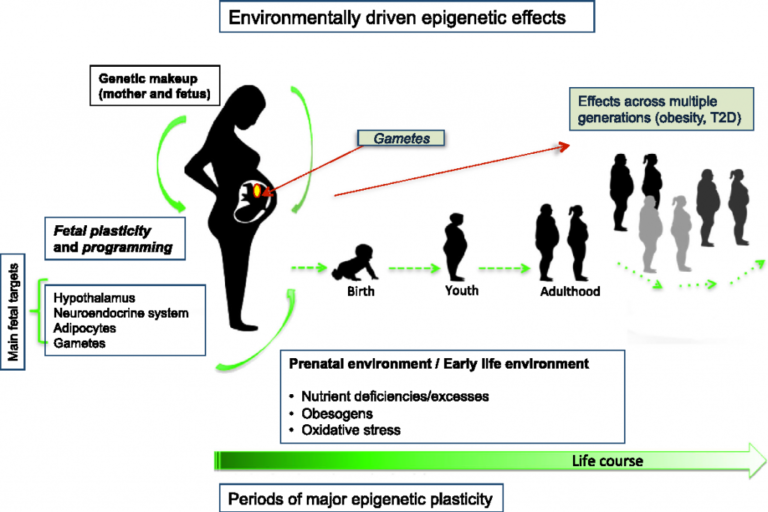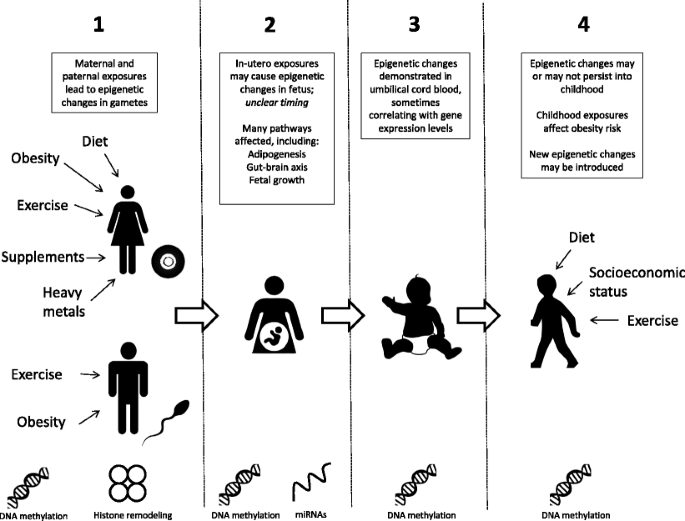Introduction and History
Epigenetics describes the study of how different environments and behaviours can adjust the way a person’s genes function. Genetics and epigenetics differ because epigenetic changes are reversible while genetic changes are not. Obesity can be defined as an individual with an accumulation of fat that exceeds the body mass index (BMI) of 30, this is the point where it can present potential risks to that individuals health (World Health Organization. [Publication Date Unknown]). Epigenetics can identify specific genes of an individual to determine the likeliness/susceptibility of becoming obese. Epigenetics and obesity affect everyone differently, it can affect different countries, different age groups and different ethnicities. Lifestyle changes are seen to play an impact in the genetic variation of an individual’s Body mass index in relation to changes in the factors of epigenetics. African American individuals have shown different epigenetic changes due to the different lifestyles being encountered. Different findings have correlated the epigenetic changes to obesity. With increasing obesity, The EWAS explores the interactions of the epigenome and the environment surroundings.
EPIGENETICS AND OBESITY IN THE UNITED STATES OF AMERICA
Obesity Rates in the USA: Past to present comparison: Obesity rates in the United States of America have drastically increased over the past 30-40 years. In 1988-1994 obesity rates in America were 22.9% amongst adults, however, in 2017-2018 obesity rates jumped to 42.4% amongst adults (Advisory Board. 2020). This means that obesity rates in adults have nearly doubled in 30 years which has put many more Americans at risk of weight related health conditions. Why are the USA’s obesity rates so much higher compared to other countries? The USA has the highest obesity rates out of all the other countries in the world. This is believed to be because of the increase in fast food sales. The average American’s diet consists of nearly 37% fast food and because fast food tends to be so high in calories, fat, sodium, etc. that 37% makes a significant difference in weight gain (Safety + Health. 2018). This is where epigenetics plays a factor, The USA is exposed to more fast food than any other country in the world and having it so easily accessible makes it a convenient option.

Epigenetics, and Obesity in Children and Teens
The USA has the highest obesity rates out of all the other countries in the world. This is believed to be because of the increase in fast food sales. The average American’s diet consists of nearly 37% fast food and because fast food tends to be so high in calories, fat, sodium, etc. that 37% makes a significant difference in weight gain (Safety + Health. 2018). This is where epigenetics plays a factor, The USA is exposed to more fast food than any other country in the world and having it so easily accessible makes it a convenient option.
Reasons for Childhood Obesity

Early Life Nutrition and Epigenetic Factors
Another factor is the impact of nutrition on fat deposition and epigenetic marks such as DNA methylation due to western dietary habits. One study examined the effects of the maternal western diet on offspring. Poor nutritional habits in western diets by mothers before their child’s birth may lead to physiological dysfunction via epigenetic changes (Tiffon, 2012). A nutrient imbalance in early life from conception to infancy influences later obesity risk suggesting that obesity could result from developmental programing. Nutrition from the utero milieu can influence obesity risk. In infancy, the use of bottled formulas rather than breastfeeding may also play a role. Animal studies have shown that altered nutrition in mothers during lactation is sufficient to determine long-term adiposity in offspring (Sharma et al., 2020

Environmental and Epigenetic Changes of African Americans
DNA methylation which shows other factors at work (Klimentidis et al., 2016). Notably, African Americans suffer a lot from chronic and cardiovascular illnesses as compared to other populations. Consequently, these chronic illnesses result in the intake of medications that would cause or contribute to obesity. Nevertheless, others conclude that the impact of family relationships and norms are a distinct factor in comorbidity in homogenous populations (Katrina et al. ,2020).

Figure 6. Showing the relationship of environmental factors in relation to genetic variation being connected to epigenetic mechanisms of DNA methylation and histone modification.These diagram shows how the environment plays a factor to the changes in our bodies.
Conclusion
Obesity rates are at an increase in America and there are many contributing factors to this issue. Having a theory of the caloric intake, one must also pay attention to what they choose on feeding their infants/children. The food fed to infants/children contributes to the different amounts of methylation.Obesity shouldn’t be blamed on an individual’s caloric intake, however, epigenetics (as seen from different studies) affects an individual’s body. The changes occur through DNA methylation. Obesity is a disease which affects different individuals with different patterns and at various stages of life.
Literature Cited
Advisory Board. December 17, 2020. Obesity in America, in 4 charts. [Accessed November 14, 2021]. https://www.advisory.com/en/daily-briefing/2020/12/17/obesity
Akinyemiju, T., Do, A.N., Patki A., Aslibekyan, S., Zhi, D., Hidalgo, B., Tiwari, H.K., Absher, D., Geng, X, Arnett, D.K., Irvin, M.R. Epigenome-wide association study of metabolic syndrome in African-American adults. 2018 [accessed 2021Nov.14];10(1). doi:10.1186/s13148-018-0483-2
Centers for Disease Control and Prevention. August 3, 2020. Genomics and Precision Health. [Accessed November 14, 2021]. https://www.cdc.gov/genomics/disease/epigenetics.htm
Campión J, Milagro FI, Martínez JA. Individuality and epigenetics in obesity. Wiley Online Library. 2009 Apr 21 [accessed 2021 Nov 14]. https://onlinelibrary.wiley.com/doi/full/10.1111/j.1467-789X.2009.00595.x
Demerath E.W., Guan, W., Grove, M.L., Aslibekyan, S., Mendelson, M., Zhou, Y-H., Hedman Åsa, K., Sandling, J.K., Li, L-A., Irvin, M.R., Zhi, D., Deloukas, P., Liang, L., Liu, C., Bressler, J., Spector, T.D., North, K., Li, Y., Absher, D.M., Levy, D., Arnett, D.K., Fornage, M., Pankow, J.S., Boerwinkle, E. Epigenome-wide association study (EWAS) of BMI, BMI change and waist circumference in African-American adults identifies multiple replicated loci. 2015 [accessed 2021Nov.14];24(15):4464-4479. doi:10.1093/hmg/ddv161
Fan He, Arthur Berg, Yuka Imamura Kawasawa, Edward O. Bixler, Julio Fernandez-Mendoza, Eric A. Whitsel and Duanping Liao. February 14, 2019. Association Between DNA Methylation in Obesity-Related Genes and Body Mass Index Percentile in Adolescents. NCBI. [Accessed November 14, 2021]. https://www.ncbi.nlm.nih.gov/pmc/articles/PMC6375997/
Lei, M-K., Beach, S.R.H., Simons, R.L., Ye, K. The impact of harsh parenting on the development of obesity in adulthood: an examination of epigenetic/gene expression mediators among African American youth. 2021 [accessed 2021Nov.14];8. doi:10.3389/fcvm.2021.755458
